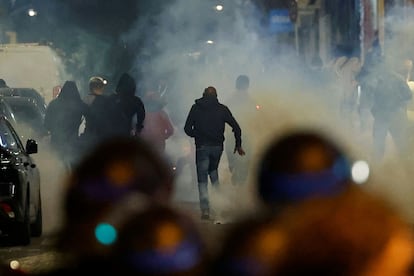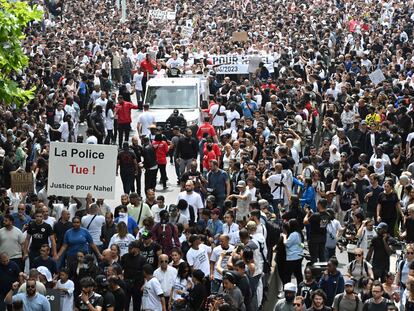Why have France’s suburbs been burning for over 40 years?
The country’s political discourse has forgotten the most important cause of violence: isolation. A collective loneliness has been feeding on the economic, social and political exclusion of the grandchildren of immigrants

Once again, hatred has gripped French suburbs and inner-cities, following the death of Nahel, a 17-year-old boy who died after being shot in the chest by a police officer.
The destruction of police stations, town halls, schools, shops and – something new this time around – the attacks on law enforcement officials with firecrackers have been repeated every night for the past week. Meanwhile, various rallies have been trying to channel the fury of the youth. Recently, a large demonstration brought together more than 800,000 people in Nantèrre – the municipality in the western suburbs of Paris where Nahel lived with his mother.
The revolt led by young French citizens of color – many of them descendants of immigrants who hail from France’s former colonies – is a social phenomenon. It’s a recurring event, which has emerged at specific moments – generally following the death of young men at the hands of the police – for more than 40 years. The first outbreaks of violence date back to the 1980, the time of the deindustrialization of the banlieues (dense suburbs) and massive youth unemployment. The first great revolt broke out in 1981, as a result of a police chase that ended with several deaths. This incident gave rise to spontaneous, disorganized and self-destructive youth-led violence. A violence that had a clear territorial limit (the neighborhood) and a moral condition: it didn’t have a desire for deadly revenge, although it clearly saw institutions, authority and power as adversities.
While these riots were never considered to be formal political actions, the revolts did recall interesting political movements of the past, such as the Beur Movement – the first anti-racist mobilization that gave a voice to young, socially-committed Franco-Maghrebis (Frenchpeople of North African descent) from the suburbs. In Paris, 100,000 people demonstrated in 1983 under the slogan, “France is a motorcycle… to move forward, you need a mixture.” Several young people were received by President François Mitterrand, who promised them that his government would reform their neighborhoods and create local police units. Extraordinarily, local associations flourished following this, offering young people a new space for political socialization.
In spite of these successes, the illusion vanished when the Socialist Party absorbed the movements. Young people felt betrayed – violence returned in the 1990s, this time with organized gangs targeting businesses, police stations and even schools. Until the most violent autumn came in 2005, with 28,000 cars burned, 4,700 people arrested and 400 sentenced to jail time. This followed the death of Ziad and Banou – 15 and 17-year-old respectively – who were killed after the police mistook them for criminals.
In the suburbs of Paris, the police aren’t a symbol of protection. Rather, officers are seen as a threat. As a sociologist, I did fieldwork in the northern suburbs of Paris after the riots of 2005, later returning to study the phenomenon again, between 2013 and 2015. Back then, the feeling was the same as it is today: nobody knew how to stop the youngsters. Not the parents, not the local educators, nor the imams and – least of all – the police. But after the violence, hope appeared again – some capable young people formed a political party called the Indigenous of the Republic. “We need to carry out this fight,” said its leader, a young woman of Algerian origin. She was a student of Arabic and English philology – I met her at one of the party’s first meetings. She explained that the “Indigenous” were the new underclass of France: “There are the upper classes, the middle classes, the workers… and below all of them are us, the descendants of colonialism, secluded in these neighborhoods, stigmatized. We’re never good enough to be recognized as French.”
Over the last three days, young people seem more organized than in the past. They communicate via Telegram or Snapchat, buying up artillery and firearms. They’re causing damage even beyond the limits of the banlieues. So far, there have also been two very serious incidents, such as the attacks on the homes of two mayors.
The question is: are they better organized and more violent this time around? It’s difficult to answer, but what’s clear is that the problem of violence is becoming more and more entrenched in French society. Today, President Emmanuel Macron doesn’t speak of racaille (scum), as Nicolas Sarkozy did in 2005 when referring to the young people. Yet, Macron continues to elude the social causes of the phenomenon, choosing to instead hold families responsible, while occasionally mentioning the effects of new technologies and video games.
For him, it seems as if the origin of violence is, simply, violence itself. The government assumes that the neighborhoods have been conquered by criminals, imposing a culture of violence which must be eradicated at all costs, with zero tolerance.
French political discourse has forgotten the most powerful cause of violence: isolation.
This collective loneliness is fed by economic, social and political exclusion. Civic participation has deteriorated to such an extent that young people feel totally disconnected from their representatives and fellow citizens. They have ceased to feel French – many are seeking a new refuge in religion. This phenomenon should cause high alert among the French political elites, because – as Hannah Arendt pointed out in The Origins of Totalitarianism – there’s a clear correlation between loneliness, that experience of “not belonging to the world,” with violence and intolerance. The truly dangerous thing isn’t the young people who are torching cars these days, but the isolation and territorial concentration of poverty that has been worsening for more than 50 years. This is despite the fact that, after each outbreak of violence, the government has made efforts to improve the neighborhoods. Still, no policies have been carried out to promote social and ethnic integration, while social housing construction hasn’t been prevalent in more central neighborhoods – a measure that could, once and for all, connect the banlieues to the city and improve their access to public transportations and services. This has been achieved in only a few cases, such as in Montreuil, Mbappé's hometown.
Finally, racial and religious discrimination is the other great barrier for young people. As the activist and sociologist Said Bouamama warns, “French racism is not built through a process of exclusion – as in Anglo-Saxon countries – but by an excessive desire for inclusion.” By wanting to desperately assimilate immigrants – as well as the children and grandchildren of immigrants – French society has created a kind of covert differentiation: one that causes young people to experience contempt, injustice and abuse of power in silence. Hence, these outbursts of anger.
Discrimination in France appears through police abuse, unequal access to employment and housing, or banks refusing to grant credit to young people of color. Meanwhile, the initiatives created by the youth of the banlieues – which demand recognition of the abuses perpetrated by colonialism and the creation of effective mechanisms against everyday racism – are despised by the elites. Oftentimes, they’re even made illegal, a recent example being the new law against “Islamist separatism” approved by Marcon in 2021.
Who represents the youth of the suburbs today? Who are envoys sent by the government when the violence breaks out? Parts of the country have been orphaned as disorder and violence reign in the streets – the state has nobody left to dialogue with, because it hasn’t given a voice to its new generations. Today, France is living the consequences of the non-inclusion of the so-called “new citizens,” who, since the 1970s, have been crying out to be recognized.
Sign up for our weekly newsletter to get more English-language news coverage from EL PAÍS USA Edition
Tu suscripción se está usando en otro dispositivo
¿Quieres añadir otro usuario a tu suscripción?
Si continúas leyendo en este dispositivo, no se podrá leer en el otro.
FlechaTu suscripción se está usando en otro dispositivo y solo puedes acceder a EL PAÍS desde un dispositivo a la vez.
Si quieres compartir tu cuenta, cambia tu suscripción a la modalidad Premium, así podrás añadir otro usuario. Cada uno accederá con su propia cuenta de email, lo que os permitirá personalizar vuestra experiencia en EL PAÍS.
¿Tienes una suscripción de empresa? Accede aquí para contratar más cuentas.
En el caso de no saber quién está usando tu cuenta, te recomendamos cambiar tu contraseña aquí.
Si decides continuar compartiendo tu cuenta, este mensaje se mostrará en tu dispositivo y en el de la otra persona que está usando tu cuenta de forma indefinida, afectando a tu experiencia de lectura. Puedes consultar aquí los términos y condiciones de la suscripción digital.
More information
Archived In
Últimas noticias
The complicated life of Francesca Albanese: A rising figure in Italy but barred from every bank by Trump’s sanctions
How Japan is trying to avert ‘digital defeat’
Half of Scotland is in the hands of 420 property owners
From digital curfews to blocking apps: How technology experts protect their children online
Most viewed
- Why we lost the habit of sleeping in two segments and how that changed our sense of time
- Pablo Escobar’s hippos: A serious environmental problem, 40 years on
- Trump’s obsession with putting his name on everything is unprecedented in the United States
- The Florida Keys tourist paradise is besieged by immigration agents: ‘We’ve never seen anything like this’
- Charles Dubouloz, mountaineering star, retires at 36 with a farewell tour inspired by Walter Bonatti










































